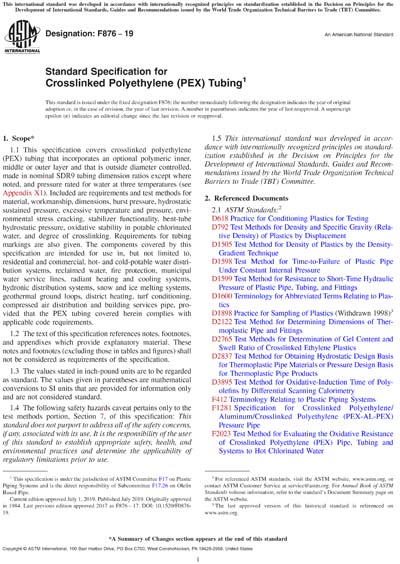Historical
ASTM F876-19
Standard Specification for Crosslinked Polyethylene (PEX) Tubing
1.1 This specification covers crosslinked polyethylene (PEX) tubing that incorporates an optional polymeric inner, middle or outer layer and that is outside diameter controlled, made in nominal SDR9 tubing dimension ratios except where noted, and pressure rated for water at three temperatures (see Appendix X1). Included are requirements and test methods for material, workmanship, dimensions, burst pressure, hydrostatic sustained pressure, excessive temperature and pressure, environmental stress cracking, stabilizer functionality, bent-tube hydrostatic pressure, oxidative stability in potable chlorinated water, and degree of crosslinking. Requirements for tubing markings are also given. The components covered by this specification are intended for use in, but not limited to, residential and commercial, hot- and cold-potable water distribution systems, reclaimed water, fire protection, municipal water service lines, radiant heating and cooling systems, hydronic distribution systems, snow and ice melting systems, geothermal ground loops, district heating, turf conditioning, compressed air distribution and building services pipe, provided that the PEX tubing covered herein complies with applicable code requirements.
1.2 The text of this specification references notes, footnotes, and appendixes which provide explanatory material. These notes and footnotes (excluding those in tables and figures) shall not be considered as requirements of the specification.
1.3 The values stated in inch-pound units are to be regarded as standard. The values given in parentheses are mathematical conversions to SI units that are provided for information only and are not considered standard.
1.4 The following safety hazards caveat pertains only to the test methods portion, Section 7, of this specification: This standard does not purport to address all of the safety concerns, if any, associated with its use. It is the responsibility of the user of this standard to establish appropriate safety, health, and environmental practices and determine the applicability of regulatory limitations prior to use.
1.5 This international standard was developed in accordance with internationally recognized principles on standardization established in the Decision on Principles for the Development of International Standards, Guides and Recommendations issued by the World Trade Organization Technical Barriers to Trade (TBT) Committee.
Content Provider
ASTM International [astm]






